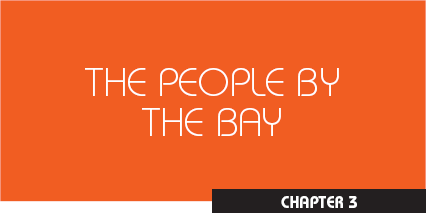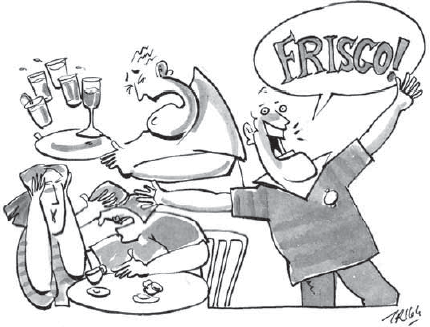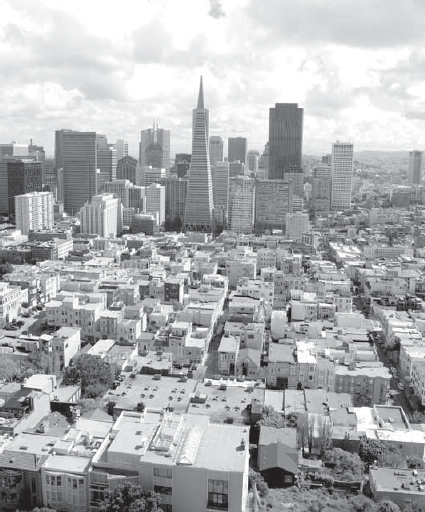

‘A mad city—inhabited for the most part by perfectly insane people whose women are of remarkable beauty.’
—Rudyard Kipling
CERTAINLY WHEN YOU COME TO SAN FRANCISCO and look around at the people you encounter on the streets, next door, or at your job, you will be wondering just what these San Franciscans “are like.” How can you understand them, get to know them, figure out where you belong? After all, in some cities and countries this is easy: in France most people are French and in Beijing they are Chinese. But in multicultural San Francisco, such classifications may not be so simple. It might well be harder to categorize the population of the City that Knows How, but this diversity and cosmopolitism might also make it easier for you—no matter your nationality or cultural orientation—to find yourself at home. Some people say that San Francisco does not fit into any specific mold. But perhaps it is that there is a mold for everyone, and if yours is not evident, then there is probably room for you to create it, yourself.
San Francisco’s demographics tell it all: more of its residents were born overseas than here. About 40 percent of San Franciscans were born in another country, 25 percent were born in another state of the United States, and only 35 percent were born in California itself. And, it is Asians—not European Caucasians—who are the primary source of international immigration to San Francisco. In 2004, 60 percent of all immigrants came from Asia, with 20 percent coming from China, alone. So, although you will see more Caucasians in business suits than any others as you walk in the Financial District, this is just one district out of many, and each neighborhood has its own vibrant ethnic or cultural ethos, waiting for you to discover.
New arrivals compare San Francisco to their own city and others they have seen, saying, “San Francisco is so European,” or “so Asian,” or “it’s not like home at all.” And they are right, or partly so: San Francisco does carry hints of other cultures on every street, but it is indeed like home, because it is home to more than 800,000 San Franciscans—of all ethnic backgrounds, religions, political persuasions, and sexual preferences—who have created this wonderful city in their image, on their own terms. San Franciscans—whoever they are and wherever they have come from, or whoever they have decided to be—are in love with their city, adore its views (visual, political, and social), appreciate its eclectic population, and in general are convinced they live in the best, most exotic city in the United States, if not the world. (And, sometimes tediously, they never stop telling everybody so.)
Another way to think about this diverse mix of people is to understand that it is a city of minorities, for no ethnic, religious, or societal group dominates. Of the 800,000 inhabitants, there are approximately 195,000 Asians, 65,000 Latinos, sizeable populations of Russians, Italians, and African Americans, and throughout all these ethnic groups, some 90,000 gays and lesbians. This leads standard tourist guides to devote separate sections to Chinatown, Japantown, the Mission, or the Castro, describing them to people passing through. But no such delineation can really help you understand the populace, for these people and their areas are each just a part of the overall scene. Part of what makes San Francisco so interesting is that each separate residential area is open enough that anyone can feel welcome, but tight enough not to lose its sense of community and identity.
So, stereotyping does not work in San Francisco. But some generalities might prove helpful as you look around. The Chinese community—like most of the other immigrant communities—tends to be close-knit, grouped in extended families, private (but not entirely closed) toward outsiders, welcoming and friendly within. And, apart from the older generations, the children—born in San Francisco, most likely—on the buses on their way home from school speak Mandarin to each other, preserving their sense of community, but also genuinely acknowledging their larger community by perhaps shouting in English, “See you tomorrow,” as they get off the bus. The Latinos in the barrio seem to be, as one might expect of people coming from warm climates, more open, teeming in the streets, laughing with friends. If you have something in common with any of these cultures—those of your heritage or outlook on life—you will understand them. But what of the rest?
Despite the delicious assortment of cultures, when people talk about what San Franciscans are like, they are generally referring to the people who work to keep the city prosperous or to further the business of the Pacific Rim, to people who own shops, buy the books, go to the ball games and the gyms, or those who explore all the superb cuisines and libations the city has to offer. Many of these are the “financial types,” the “yuppies” (young urban professionals), the “metrosexuals,” or the “dot.comers” that San Francisco is known for, and if we are talking about them, then we can surely give some clues as to who they are.
If you have not noticed it by now, you will soon. San Franciscans like to play. They may love (or hate) their work and strive to succeed, but their lives outside their jobs define more of who they are. They eat out often, go to films, spend discretionary dollars on fitness and sport, look for the trendiest cocktail of the moment—downing quite a few—and, liking to look good, they shop. (They do not smoke, for the most part—and they will not hesitate to chide you if you do!) Yes, the “dot.com” bubble burst and a recession hit worldwide, but somehow San Francisco remains itself. Wages in San Francisco rose 30 percent in the last decade, whereas in the rest of the country they rose only 18 percent. And if the cost of living is also higher here, somehow it seems not to matter to these people, or not much. As families with children move away to where raising children is more affordable, young professionals are still sliding right in to take their place.
As already mentioned, the climate is agreeable year-round, and the views are exquisite. Acquaintances are friendly and open, and the best of everything is not hard to find. No wonder people seem light-hearted and ready for themselves and everyone else to have fun. And they have come to the right city, for there is something about San Francisco, itself, that makes it all work.
If Americans have found that it is easier to get along together by avoiding talk of politics, sex, and religion—San Francisco begs to differ. A sense of humor is important, and San Francisco encourages its lovers to think that anything—and anybody—can be teased, even themselves.
Where else would you have found the citizens of a city irreverently twitting a rather imperial mayor Willie Brown by referring to him as “His Williness?” Where else would you find a group of gay men forming an “order” of nuns, “The Sisters of Perpetual Indulgence,” with one of those men—Sister Boom Boom—running for a seat in the Board of Supervisors, as “nun of the above?” (This happened in 1982, and although some 23,000 voted for him, the votes were not enough for him to win.) And where else would the electorate have countermanded the police department’s prohibition, voting that a friendly policeman could carry a ventriloquist’s dummy wearing a little police uniform on his beat? These all happened over the years, and these stories quickly go into the city’s legends and lore.
Should you find some of the humor distasteful, just roll your eyes and shake your head, for San Francisco’s enjoyment of the outrageous goes far back and it has encompassed all strata of the city’s society. Take the case of one Joshua Abraham Norton. Having left San Francisco in the mid-1850s a financial failure, he returned just a few months later styling himself as “Emperor of the United States and Protector of Mexico.” His proclamations were published in the newspapers, and he became the “darling of everybody in town.” For 20 years Emperor Norton sported regal finery, was fed for free at various establishments around the city, and pontificated at corporation board meetings. When he died in 1880, he was given a fittingly royal funeral, to which 10,000 of his “subjects” came.
Two of Emperor Norton’s Noteworthy Decrees
It was Emperor Norton who first admonished the citizenry never to call their city Frisco.
“Whoever after due and proper warning shall be heard to utter the abominable word ‘Frisco,’ which has no linguistic or other warrant, shall be deemed guilty of a High Misdemeanor.”
His quirky yet brilliant vision of having a bridge constructed over the bay was disregarded and realized only in 1937—a milestone in San Francisco’s existence—when the world-renowned Golden Gate Bridge was opened.

San Francisco’s iconic Golden Gate Bridge, completed in 1937, a symbol of human ingenuity. With the Pacific Ocean to its west and the Bay to the east, it spans the Golden Gate, discovered by Spanish soldiers in 1769.
And a century later, in 1999, when gay politician Tom Ammiano was sworn in as President of the Board of Supervisors, his predecessor gave him a tiara and feathered scepter she had received at the beginning of her term, and declared him “queen of the realm.” Acknowledging the change in the city’s leadership and in societal tolerance, Ammiano responded by quoting from The Wizard of Oz, a movie favorite, “We’re not in Kansas anymore.”
In fact, San Francisco from its beginnings was a town of men: the priests and soldiers who adventured north to Alta California to settle the area two centuries ago, the Chinese men fleeing famine who sailed the Pacific, and the adventurers who flocked to the California frontier in 1849 seeking gold. That the miners also sought booze and bawdy women convinced some moralists that the city should be punished, and after the 1906 earthquake they thought it had been. (Not likely!) But a port city it was and it remained, welcoming more sailors after the opening of the Panama Canal in 1914 and ship workers through World War II. During the war, San Francisco was a military port of embarkation, where eagle-eyed officers mustered out men who were homosexual, many of whom then decided to stay. By the 1960s, when it was said that the 70,000 gays who lived here frequented “decadent” gay bars, national newspapers stereotyped the city as a haven for sexual deviates. Far from having the desired effect, the news spread throughout the country that this was a place for gays and other iconoclasts to feel at home. And when gay San Francisco Supervisor and activist Harvey Milk was assassinated in 1978, the gay community mobilized itself and has since become a potent political force.
For quite some time the city has had a precedent-setting, official stance on affording equal rights to domestic partners of any persuasion. And, when Gavin Newsom was elected as mayor in December 2003, he declared gay marriages to be legal. But he was ahead of his time. In 2008 the anti-gay marriage bloc carried the majority and voted that marriage in California is “between a man and a woman.” The state Supreme Court upheld the vote, but declared that the 18,000 marriages already performed were valid. Yet the campaign isnt’t over: one can only say at this point, as they do on television, “stay tuned.”
If The City was once primarily the province of male gays—in the Haight and Polk Gulch, and of course the Castro—and lesbians were more prominent across the Bay in Oakland, this has been changing for some time. In recent decades, the lesbian community has been establishing itself solidly throughout the city, especially in the Inner Mission, Noe Valley, Bernal Heights, and Glen Park. And now, the dynamic district of SoMa is happily welcoming to the entire city.
Unfortunately, “hate crimes” occur from time to time in America, but they are rare here, for San Franciscans tend to get along in harmony. That you can find a beautifully dressed society matron at the opera sitting just one row away from a Rastafarian sporting dreadlocks and wearing blue jeans is not a paradox. That you can find a middle-aged straight couple eating a delicious dinner at Asia SF, a transvestite “gender illusion” café, is not unusual. That you can find one of the best martinis in town at a bar in the seedy Inner Mission does not keep anyone away. And that a distinguished looking gentleman driving a Mercedes can order take-out ribs from a shack called Brother-in-Law’s #2, in the Western Addition, means only that he has good taste. (And no one cares that there is no Brother-in-Law’s #1.) Since its beginnings, San Francisco has carried the country’s vision of the “melting pot” where differing societal cultures and attitudes enrich the whole. What is different about San Francisco is that each mini-society in its own way embraces this vision and is—at least for the most part and on most days—proud of it.

Towers of commerce cluster together in the Financial District, leaving residential districts with a human scale.
Even more unlike some other cities in this emerging century, San Francisco is managing to triumph, in its own unique way. The intensity San Franciscans bring to their lives translates into a civic activism that cuts through all levels of society. As that former Mayor Brown once said, “Here in San Francisco, you have more than 750,000 people, and each and every one of them is informed, interested, and has an opinion on everything.” It is true. Residents volunteer at food banks that feed the homeless, at non-profit cultural institutions, for environmental and political causes, and at organizations for needy children. They form groups to protest injustice and to call for reform. They insist volubly on better transportation, more parking, and more affordable housing. They vote in higher percentages than in most other major cities, and if it appears that San Francisco is at the far side of “liberal,” look at the most talked-about issues and see that residents vote for the very things that make their city work: good social programs, preservation of cultural institutions, improvement of the downtown areas, and equality and tolerance for all.
And again: where else would all levels of society flock to an elegant restaurant on the Embarcadero (Delancey Street) that is staffed entirely by former drug addicts and felons who, having hit bottom, are now on their way back up? And where else would a Methodist church (Glide Memorial) in the gritty Tenderloin district that feeds hundreds each day at its soup kitchen also draw more than a thousand San Franciscans of all strata and religious beliefs on Sunday mornings to its rafter-raising, rocking, gospel message?
So all this is quintessentially San Franciscan, and it is the San Franciscans who have made it and continue to make it so. You will discover all this for yourself as you settle in. Look around. This eclectic population known as San Franciscans, whether they say so or not, hope—no, they assume—that you will find your place among them. And, no doubt, you will.